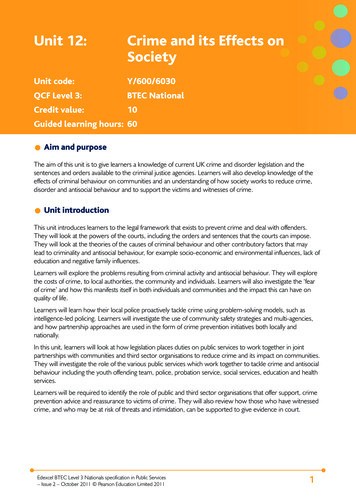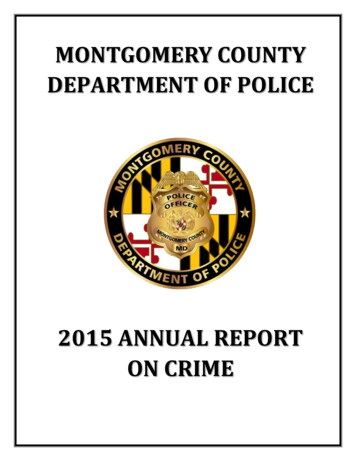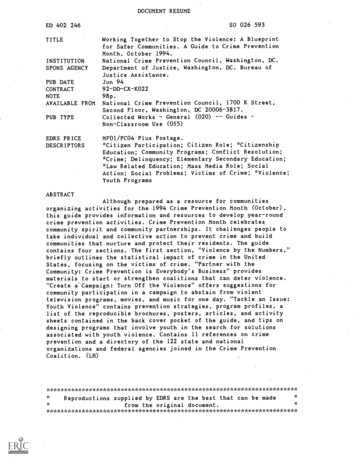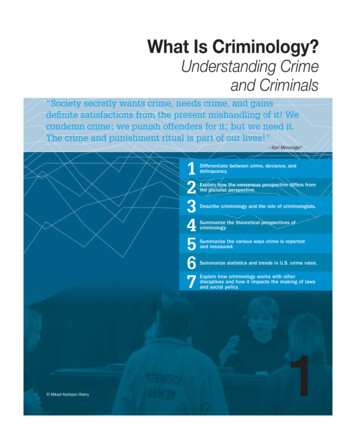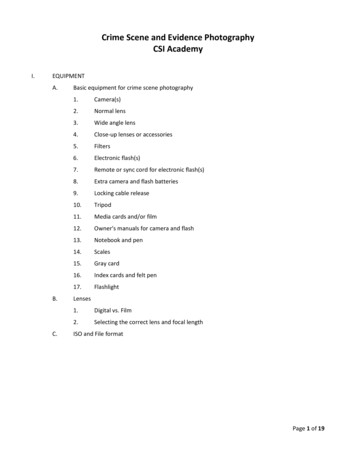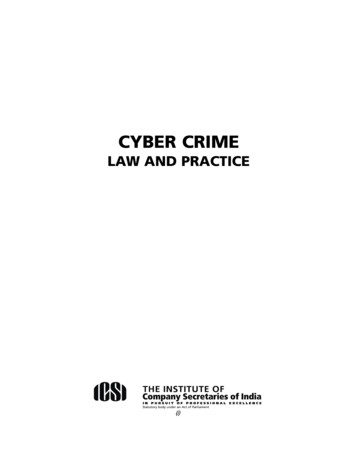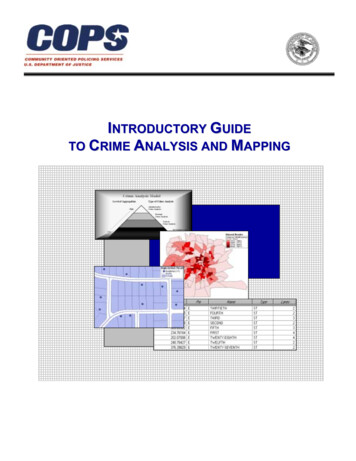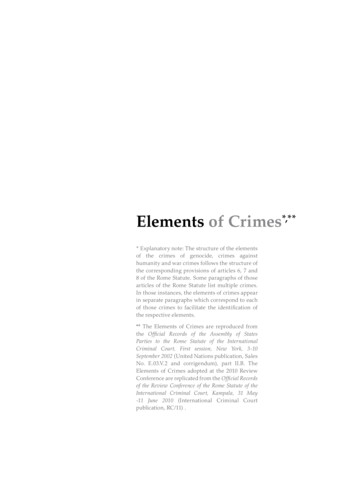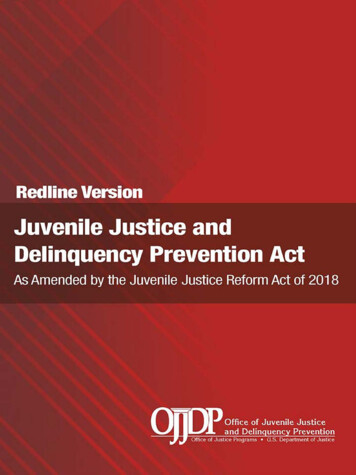
Transcription
Title 34. Crime Control and Law EnforcementSubtitle I. Comprehensive ActsChapter 111. Juvenile Justice and Delinquency PreventionSubchapter I. Generally§11101. Findings(a) TheCongress finds the following:(1) Although the juvenile violent crime arrest rate in 1999 was the lowestin the decade, thereremains a consensus that the number of crimes and the rate of offending by juveniles nationwideis still too high.(2) According to the Office of JuvenileJustice and Delinquency Prevention, allowing 1 youth toleave school for a life of crime and of drug abuse costs society 1,700,000 to 2,300,000annually.One in every 6 individuals (16.2 percent) arrested for committing violent crime in 1999 wasless than 18 years of age. In 1999, juveniles accounted for 9 percent of murder arrests, 17 percentof forcible rape arrests, 25 percent of robbery arrest, 14 percent of aggravated assault arrests, and24 percent of weapons arrests.(3)More than ½ of juvenile murder victims are killed with firearms. Of the nearly 1,800 murdervictims less than 18 years of age, 17 percent of the victims less than 13 years of age weremurdered with a firearm, and 81 percent of the victims 13 years of age or older were killed with afirearm.(4)Juveniles accounted for 13 percent of all drug abuse violation arrests in 1999. Between 1990and 1999, juvenile arrests for drug abuse violations rose 132 percent.(5)Over the last 3 decades, youth gang problems have increased nationwide. In the 1970's, 19States reported youth gang problems. By the late 1990's, all 50 States and the District ofColumbia reported gang problems. For the same period, the number of cities reporting youthgang problems grew 843 percent, and the number of counties reporting gang problems increasedmore than 1,000 percent.(6)(7) Accordingto a national crime survey of individuals 12 years of age or older during 1999, those12 to 19 years old are victims of violent crime at higher rates than individuals in all other age1
groups. Only 30.8 percent of these violent victimizations were reported by youth to police in1999.One-fifth of juveniles 16 years of age who had been arrested were first arrested beforeattaining 12 years of age. Juveniles who are known to the juvenile justice system beforeattaining 13 years of age are responsible for a disproportionate share of serious crimes andviolence.(8)2
The increase in the arrest rates for girls and young juvenile offenders has changed thecomposition of violent offenders entering the juvenile justice system.(9)These problems should be addressed through a 2-track common sense approach thataddresses the needs of individual juveniles and society at large by promoting-(10)(A) qualityprevention programs that--work with juveniles, their families, local public agencies, and community-basedorganizations, and take into consideration such factors as whether or not juveniles have beenthe victims of family violence (including child abuse and neglect); and(i)are designed to reduce risks and develop competencies in at-risk juveniles that willprevent, and reduce the rate of, violent delinquent behavior; and(ii)programs that assist in holding juveniles accountable for their actions and in developing thecompetencies necessary to become responsible and productive members of their communities,including a system of graduated sanctions to respond to each delinquent act, requiring juvenilesto make restitution, or perform community service, for the damage caused by their delinquentacts, and methods for increasing victim satisfaction with respect to the penalties imposed onjuveniles for their acts.(B)Coordinated juvenile justice and delinquency prevention projects that meet the needs ofjuveniles through the collaboration of the many local service systems juveniles encounter canhelp prevent juveniles from becoming delinquent and help delinquent youth return to aproductive life.(11)(b) Congressmust act now to reform this program by focusing on juvenile delinquency preventionprograms, as well as programs that hold juveniles accountable for their acts and which provideopportunities for competency development. Without true reform, the juvenile justice system willnot be able to overcome the challenges it will face in the coming years when the number ofjuveniles is expected to increase by 18 percent between 2000 and 2030.3
§11102. PurposesThe purposes of this subchapter and subchapter II are--(1) tosupport State, tribal, and local programs that prevent juvenile involvement in delinquentbehavior;(2) toassist State, tribal, and local governments in promoting public safety by encouragingaccountability for acts of juvenile delinquency; and4
DefinitionsDefinitions
to assist State, tribal, and local governments in addressing juvenile crime through the provisionof technical assistance, research, training, evaluation, and the dissemination of current andrelevant information on effective and evidence-based programs for combating juveniledelinquency; and.(3)(4) to support a continuum of evidence-based or promising programs (including delinquencyprevention, intervention, mental health, behavioral health and substance abuse treatment, familyservices, and services for children exposed to violence) that are trauma informed, reflect the science ofadolescent development, and are designed to meet the needs of at risk youth and youth who come intocontact with the justice system.§11103. DefinitionsFor purposes of this chapter-the term “community based” facility, program, or service means a small, open group home orother suitable place located near the juvenile's home or family and programs of communitysupervision and service which maintain community and consumer participation in the planningoperation, and evaluation of their programs which may include, but are not limited to, medical,educational, vocational, social, and psychological guidance, training, special education,counseling, alcoholism treatment, drug treatment, and other rehabilitative services;(1)the term “Federal juvenile delinquency program” means any juvenile delinquency programwhich is conducted, directly, or indirectly, or is assisted by any Federal department or agency,including any program funded under this chapter;(2)the term “juvenile delinquency program” means any program or activity related to juveniledelinquency prevention, control, diversion, treatment, rehabilitation, planning, education,training, and research, including drug and alcohol abuse programs; the improvement of thejuvenile justice system; and any program or activity designed to reduce known risk factors forjuvenile delinquent behavior, provides 1 activities that build on protective factors for, and(3)develop competencies in, juveniles to prevent, and reduce the rate of, delinquent juvenilebehavior;(4)(A) the term “Bureau of Justice Assistance” means the bureau established by section 10141 ofthis title;5
(B) theterm “Office of Justice Programs” means the office established by section 10101 of thistitle;(C) theterm “National Institute of Justice” means the institute established by section 10122(a) ofthis title; and(D)the term “Bureau of Justice Statistics” means the bureau established by section 10132(a) of thistitle;(5) theterm “Administrator” means the agency head designated by section 11111(b) of this title;the term “law enforcement and criminal justice” means any activity pertaining to crimeprevention, control, or reduction or the enforcement of the criminal law, including, but notlimited to police efforts to prevent, control, or reduce crime or to apprehend criminals, activitiesof courts having criminal jurisdiction and related agencies (including prosecutorial and defenderservices), activities of corrections, probation, or parole authorities, and programs relating to theprevention, control, or reduction of juvenile delinquency or narcotic addiction;(6)6
the term “State” means any State of the United States, the District of Columbia, theCommonwealth of Puerto Rico, the Virgin Islands, Guam, American Samoa, and theCommonwealth of the Northern Mariana Islands;(7)(8) theterm “unit of local government” means--any city, county, township, town, borough, parish, village, or other general purpose politicalsubdivision of a State;(A)(B) any(i) islaw enforcement district or judicial enforcement district that--established under applicable State law; and(ii) has the authority to, in a manner independent of other State entities, establish a budgetand raise revenues; or(C) anIndian Tribe that performs law enforcement functions, as determined by the Secretary ofthe Interior; orfor the purposes of assistance eligibility, any agency of the government of the Districtof Columbia or the Federal Government that performs law enforcement functions in and for-(D)(C)(i) theDistrict of Columbia; or(ii) anyTrust Territory of the United States;(9) the term “combination” as applied to States or units of local government means any groupingor joining together of such States or units for the purpose of preparing, developing, orimplementing a juvenile justice and delinquency prevention plan;(10) the term “construction” means acquisition, expansion, remodeling, and alteration of existingbuildings, and initial equipment of any such buildings, or any combination of such activities(including architects' fees but not the cost of acquisition of land for buildings);(11) theterm “public agency” means any State, unit of local government, combination of such7
States or units, or any department, agency, or instrumentality of any of the foregoing;(12) theterm “secure detention facility” means any public or private residential facility which--(A) includesconstruction fixtures designed to physically restrict the movements and activities ofjuveniles or other individuals held in lawful custody in such facility; and8
is used for the temporary placement of any juvenile who is accused of having committed anoffense or of any other individual accused of having committed a criminal offense;(B)(13) theterm “secure correctional facility” means any public or private residential facility which--(A) includesconstruction fixtures designed to physically restrict the movements and activities ofjuveniles or other individuals held in lawful custody in such facility; and(B) is used for theplacement, after adjudication and disposition, of any juvenile who has beenadjudicated as having committed an offense or any other individual convicted of a criminaloffense;the term “serious crime” means criminal homicide, forcible rape or other sex offensespunishable as a felony, mayhem, kidnapping, aggravated assault, drug trafficking, robbery,larceny or theft punishable as a felony, motor vehicle theft, burglary or breaking and entering,extortion accompanied by threats of violence, and arson punishable as a felony;(14)(15) theterm “treatment” includes but is not limited to medical, educational, special education,social, psychological, and vocational services, corrective and preventive guidance and training,and other rehabilitative services designed to protect the public, including services designed tobenefit addicts and other users by eliminating their dependence on alcohol or other addictive ornonaddictive drugs or by controlling their dependence and susceptibility to addiction or use;(16) theterm “valid court order” means a court order given by a juvenile court judge to a juvenile--(A) who wasbrought before the court and made subject to such order; andwho received, before the issuance of such order, the full due process rights guaranteed tosuch juvenile by the Constitution of the United States;(B)(17) theterm “Council” means the Coordinating Council on Juvenile Justice and DelinquencyPrevention established in section 11116(a)(1) of this title;(18) forpurposes of title II, the term “Indian tribe” means-9
(A) afederally recognized Indian tribe; or(B) anAlaskan Native organization;that has a law enforcement function, as determined by the Secretary of the Interior in consultation withthe Attorney General;10
(19) theterm “comprehensive and coordinated system of services” means a system that--ensures that services and funding for the prevention and treatment of juvenile delinquencyare consistent with policy goals of preserving families and providing appropriate services in theleast restrictive environment so as to simultaneously protect juveniles and maintain publicsafety;(A)identifies, and intervenes early for the benefit of, young children who are at risk ofdeveloping emotional or behavioral problems because of physical or mental stress or abuse, andfor the benefit of their families;(B)increases interagency collaboration and family involvement in the prevention and treatmentof juvenile delinquency; and(C)(D) encourages private and public partnerships in the delivery of services for the prevention andtreatment of juvenile delinquency;(20) the term “gender-specific services” means services designed to address needs unique to thegender of the individual to whom such services are provided;the term “home-based alternative services” means services provided to a juvenile in the homeof the juvenile as an alternative to incarcerating the juvenile, and includes home detention;(21)the term “jail or lockup for adults” means a locked secure facility that is used by a State, unitof local government, or any law enforcement authority to detain or confine adults inmates-(22)(A) pendingthe filing of a charge of violating a criminal law;(B) awaitingtrial on a criminal charge; or(C) convictedof violating a criminal law;(23) the term “nonprofit organization” means an organization described in section 501(c)(3) ofTitle 26 that is exempt from taxation under section 501(a) of Title 26;11
the term “graduated sanctions” means an accountability-based, graduated series of sanctions(including incentives, treatment, and services) applicable to juveniles within the juvenile justicesystem to hold such juveniles accountable for their actions and to protect communities from theeffects of juvenile delinquency by providing appropriate sanctions for every act for which ajuvenile is adjudicated delinquent, by inducing their law-abiding behavior, and by preventingtheir subsequent involvement with the juvenile justice system;(24)12
term “contact” means the degree of interaction allowed between juvenile offendersin a secure custody status and incarcerated adults under section 31.303(d)(1)(i) of title 28,Code of Federal Regulations, as in effect on December 10, 1996 “sight or sound contact”means any physical, clear visual, or verbal contact that is not brief and inadvertent;(25) the(26) theterm “adult inmate” means an individual who--(A) meansan individual who—(i) has reached the age of full criminal responsibility under applicable State law; and(ii) has been arrested and is in custody for or awaiting trial on a criminal charge, or isconvicted of a criminal offense; and(B) does not include an individual who—(i) at the time of the offense, was youngerthan the maximum age at which a youth can beheld in a juvenile facility under applicable State law; and(ii)was committed to the care and custody or supervision, including post-placement orparole supervision, of a juvenile correctional agency by a court of competent jurisdictionor by operation of applicable State law;(27) theterm “violent crime” means--(A) murder or nonnegligent(B) aggravatedmanslaughter, forcible rape, or robbery, orassault committed with the use of a firearm;the term “collocated facilities” means facilities that are located in the same building,or are part of a related complex of buildings located on the same grounds; and(28)(29) theterm “related complex of buildings” means 2 or more buildings that share--physical features, such as walls and fences, or services beyond mechanical services(heating, air conditioning, water and sewer); or(A)(B)the specialized services that are allowable under section 31.303(e) (3)(i)(C)(3) of title13
28 of the Code of Federal Regulations, as in effect on December 10, 1996;.(30) the term “core requirements”—(A) means the requirements described in paragraphs (11), (12), (13), and (15) ofsection 223(a); and(B) does not include the data collection requirements described in subparagraphs(A) through (K) of section 207(1);(31) the term “chemical agent” means a spray or injection used to temporarilyincapacitate a person, including oleoresin capsicum spray, tear gas, and 2chlorobenzalmalononitrile gas;(32) the term “isolation”—(A) means any instance in which a youth is confined alone for more than 15 minutesi n a r oom or cell; and(B) does not include—(i) confinement during regularly scheduled sleeping hours;(ii) separation based on a treatment program approved by a licensed medical ormental health professional;(iii) confinement or separation that is requested by the youth; or(iv) the separation of the youth from a group in a nonlocked setting for thelimited purpose of calming;(33) the term “restraints” has the meaning given that term in section 591 of the PublicHealth Service Act (42 U.S.C. 290ii);(34) the term “evidence-based” means a program or practice that—(A) is demonstrated to be effective when implemented with fidelity;(B) is based on a clearly articulated and empirically supported theory;(C) has measurable outcomes relevant to juvenile justice, including a detailed descriptionof the outcomes produced in a particular population, whether urban or rural; and(D) has been scientifically tested and proven effective through randomized controlstudies or comparison group studies and with the ability to replicate and scale;(35) the term “promising” means a program or practice that—14
(A) is demonstrated to be effective based on positive outcomes relevant to juvenile justicefrom one or more objective, independent, and scientifically valid evaluations, as documentedin writing to the Administrator; and(B) will be evaluated through a well-designed and rigorous study, as described inparagraph (34)(D);(36) the term “dangerous practice” means an act, procedure, or program that creates anunreasonable risk of physical injury, pain, or psychological harm to a juvenile subjected to theact, procedure, or program;(37) the term “screening” means a brief process—(A) designed to identify youth who may have mental health, behavioral health, substanceabuse, or other needs requiring immediate attention, intervention, and further evaluation;and(B) the purpose of which is to quickly identify a youth with possible mental health,behavioral health, substance abuse, or other needs in need of further assessment;(38) the term “assessment” includes, at a minimum, an interview and review of available recordsand other pertinent information—(A) by an appropriately trained professional who is licensed or certified by theapplicable State in the mental health, behavioral health or substance abuse fields; and(B) which is designed to identify significant mental health, behavioral health, or substanceabuse treatment needs to be addressed during a youth’s confinement;(39) for purposes of section 223(a)(15), the term “contact” means the points at which a youthand the juvenile justice system or criminal justice system officially intersect, includinginteractions with a juvenile justice, juvenile court, or law enforcement official;(40) the term “trauma-informed” means—(A) understanding the impact that exposure to violence and trauma have on a youth’sphysical, psychological, and psychosocial development;(B) recognizing when a youth has been exposed to violence and trauma and is in needof help to recover from the adverse impacts of trauma; and15
(C) responding in ways that resist retraumatization;(41) the term “racial and ethnic disparity” means minority youth populations are involved at adecision point in the juvenile justice system at disproportionately higher rates than non-minorityyouth at that decision point;(42) the term “status offender” means a juvenile who is charged with or who has committed anoffense that would not be criminal if committed by an adult;(43) the term “ rural” means an area that is not located in a metropolitan statistical area, asdefined by the Office of Management and Budget;(44) the term “ internal controls” means a process implemented to provide reasonable assuranceregarding the achievement of objectives in—(A) effectiveness and efficiency of operations, such as grant management practices;(B) reliability of reporting for internal and external use; and(C) compliance with applicable laws and regulations, as well as recommendations of theOffice of Inspector General and the Government Accountability Office; and(45) the term “tribal government” means the governing body of an Indian Tribe.16
Title 34. Crime Control and Law EnforcementSubtitle I. Comprehensive ActsChapter 111. Juvenile Justice and Delinquency PreventionSubchapter II. Programs and OfficesPart A. Juvenile Justice and Delinquency Prevention Office§11111. Establishment(a)Placement within Department of Justice under general authority of Attorney GeneralThere is hereby established an Office of Juvenile Justice and Delinquency Prevention (hereinafter inthis division referred to as the “Office”) within the Department of Justice under the general authorityof the Attorney General.(b)Administrator; head, appointment, authorities, etc.The Office shall be headed by an Administrator (hereinafter in this subchapter referred to asthe “Administrator”) appointed by the President from among individuals who have hadexperience in juvenile justice programs. The Administrator is authorized to prescriberegulations consistent with this chapter to award, administer, modify, extend, terminate, monitor,evaluate, reject, or deny all grants and contracts from, and applications for, funds made availableunder this subchapter. The Administrator shall have the same reporting relationship with theAttorney General as the directors of other offices and bureaus within the Office of JusticePrograms have.(c)Deputy Administrator; appointment, functions, etc.There shall be in the Office a Deputy Administrator who shall be appointed by the AttorneyGeneral. The Deputy Administrator shall perform such functions as the Administrator may fromtime to time assign or delegate and shall act as the Administrator during the absence or disabilityof the Administrator.§11112. Personnel(a)Selection; employment; compensationThe Administrator is authorized to select, employ, and fix the compensation of such officers andemployees, including attorneys, as are necessary to perform the functions vested in theAdministrator and to prescribe their functions.17
(b) SpecialpersonnelThe Administrator is authorized to select, appoint, and employ not to exceed three officers and tofix their compensation at rates not to exceed the rate now or hereafter payable under section5376 of Title 5.(c)Personnel from other agenciesUpon the request of the Administrator, the head of any Federal agency is authorized to detail, ona reimbursable basis, any of its personnel to the Administrator to assist the Administrator incarrying out the functions of the Administrator under this subchapter.(d) Expertsand consultantsThe Administrator may obtain services as authorized by section 3109 of Title 5, at rates not toexceed the rate now or hereafter payable under section 5376 of Title 5.18
§11113. Voluntary and uncompensated servicesThe Administrator is authorized to accept and employ, in carrying out the provisions of this chapter,voluntary and uncompensated services notwithstanding the provisions of section 1342 of Title 31.§11114. Concentration of Federal efforts(a)Implementation of policy by Administrator; consultation with Council and Advisory CommitteeThe Administrator shall develop objectives, priorities, and a long-term plan, and implementlong term plan to improve the juvenile justice system in the United States, taking into accountscientific knowledge regarding adolescent development and behavior and regarding the effects ofdelinquency prevention programs and juvenile justice interventions on adolescents, and shallimplement overall policy and a strategy to carry out such plan, for all Federal juveniledelinquency programs and activities relating to prevention, diversion, training, treatment,rehabilitation, evaluation, and research, and improvement of the juvenile justice system in theUnited States. In carrying out the functions of the Administrator, the Administrator shall consultwith the Council.(1)(2)(A) The plan described in paragraph (1) shall--contain specific goals and criteria for making grants and contracts, for conducting research,and for carrying out other activities under this subchapter; and(i)(ii) provide for coordinating the administration programs and activities under this subchapterwith the administration of all other Federal juvenile delinquency programs and activities,including proposals for joint funding to be coordinated by the Administrator.The Administrator shall review the plan described in paragraph (1) annually, revise the planas the Administrator considers appropriate, and publish the plan in the Federal Register duringthe 30-day period ending on October 1 of each year.-(B)(i) notlater than 240 days after November 4, 1992, in the case of the initial plan required byparagraph (1); and19
(ii)(i)(b) Dutiesexcept as provided in clause (i), in the 30-day period ending on October 1 of each year.of AdministratorIn carrying out the purposes of this chapter, the Administrator shall--advise the President through the Attorney General as to all matters relating to federallyassisted juvenile delinquency programs and Federal policies regarding juvenile delinquency;(1)20
(2) assist operating agencies which have direct responsibilities for the prevention and treatment ofjuvenile delinquency in the development and promulgation of regulations, guidelines,requirements, criteria, standards, procedures, and budget requests in accordance with the policies,priorities, and objectives the Administrator establishes;conduct and support evaluations and studies of the performance and results achieved byFederal juvenile delinquency programs and activities;(3)implement Federal juvenile delinquency programs and activities among Federaldepartments and agencies and between Federal juvenile delinquency programs and activitiesand other Federal programs and activities which the Administrator determines may have animportant bearing on the success of the entire Federal juvenile delinquency effort;(4)not later than 1 year after the date of enactment of the Juvenile Justice Reform Act of 2018,in consultation with Indian Tribes, develop a policy for the Office of Juvenile Justice andDelinquency Prevention to collaborate with representatives of Indian Tribes with a criminal justicefunction on the implementation of the provisions of this Act relating to Indian Tribes;(5)(56)(A) develop for each fiscal year, and publish annually in the Federal Register for publiccomment, a proposed comprehensive plan describing the particular activities which theAdministrator intends to carry out under parts D and E in such fiscal year, specifying in detailthose activities designed to satisfy the requirements of parts D and E; and(B) taking into consideration comments received during the 45-day period beginning on the datethe proposed plan is published, develop and publish a final plan, before December 31 of suchfiscal year, describing the particular activities which the Administrator intends to carry out underparts D and E in such fiscal year, specifying in detail those activities designed to satisfy therequirements of parts D and E; and(7) provide for the auditing of monitoring systems required under section 11133(a)(15) section223(a)(14) of this title to review the adequacy of such systemsfor monitoring compliance; and(7)not later than 1 year after November 2, 2002, issue model standards for providing mental health careto incarcerated juveniles.(c)Information, reports, studies, and surveys from other agencies21
The Administrator may require, through appropriate authority, Federal departments andagencies engaged in any activity involving any Federal juvenile delinquency program to providethe Administrator with such information as may be appropriate to prevent the duplication ofefforts, and to coordinate activities, related to the prevention of juvenile delinquency.(d) Delegationof functionsThe Administrator shall have the sole authority to delegate any of the functions of theAdministrator under this chapter.(e)Utilization of services and facilities of other agencies; reimbursement22
The Administrator is authorized to utilize the services and facilities of any agency of the FederalGovernment and of any other public agency or institution in accordance with appropriateagreements, and to pay for such services either in advance or by way of reimbursement as may beagreed upon.(f)Coordination of functions of Administrator and Secretary of Health and Human ServicesAll functions of the Administrator under this subchapter shall be coordinated as appropriate withthe functions of the Secretary of Health and Human Services under subchapter III of thischapter.§11115. Joint funding; non-Federal share requirementsNotwithstanding any other provision of law, where funds are made available by more than oneFederal agency to be used by any agency, organization, institution, or individual to carry out aFederal juvenile delinquency program or activity, any one of the Federal agencies providingfunds may be requested by the Administrator to act for all in administering the funds advancedwhenever the Administrator finds the program or activity to be exceptionally effective or forwhich the Administrator finds exceptional need. In such cases, a single non-Federal sharerequirement may be established according to the proportion of funds advanced by each Federalagency, and the Administrator may order
Chapter 111. Juvenile Justice and Delinquency Prevention Subchapter I. Generally §11101. Findings (a) The Congress finds the following: (1) Although the juvenile violent crime arrest rate in 1999 was the lowest in the decade, there remains a consensus that the number of crimes and the rat
